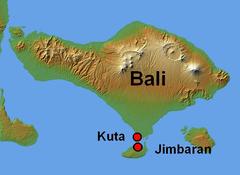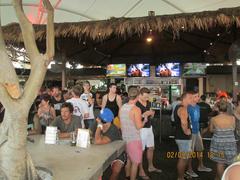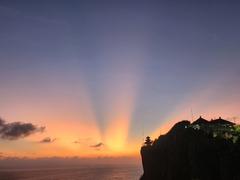Pecatu Visiting Guide: Badung, Indonesia — Historical Sites, Tickets, and Tips
Date: 15/06/2025
Introduction to Pecatu and Its Historical Sites
Pecatu, located on the stunning western edge of Bali’s Bukit Peninsula, is famed for its breathtaking limestone cliffs, secluded beaches, and the majestic Uluwatu Temple (Pura Luhur Uluwatu). This region is a harmonious blend of natural beauty, vibrant local traditions, and deep spiritual significance. Uluwatu Temple, perched dramatically 70 meters above the Indian Ocean, is one of Bali’s six sacred directional temples, integral to both island protection and cultural identity. With roots tracing back to the 10th and 11th centuries, and expanded by revered sages such as Empu Kuturan and Dang Hyang Nirartha, Uluwatu Temple is a living embodiment of Balinese Hinduism and the philosophy of harmony between humanity, nature, and the divine (Budaya Bali, Balistarisland, Balicheapesttours).
Pecatu is also a haven for surfers, beach enthusiasts, and cultural travelers. From world-famous surf breaks like Padang Padang and Dreamland to vibrant Kecak dance performances at Uluwatu Temple, the area offers a rich tapestry of experiences. This guide provides detailed insights into Pecatu’s history, spiritual sites, travel tips, and practical information to help you plan a memorable visit (Trip101, The Honeycombers).
Contents
- Introduction
- Early Settlement and Geography
- Spiritual Heritage: Uluwatu Temple
- History and Significance
- Visiting Hours and Tickets
- What to Expect
- Accessibility and Tips
- Beaches and Surf Culture
- Modern Development and Community Life
- Environmental and Cultural Preservation
- Visitor Information
- Nearby Attractions
- Guided Tours and Photographic Spots
- FAQ
- Conclusion and Recommendations
- Sources
Early Settlement and Geographic Context
Pecatu is a coastal village in South Kuta, Badung Regency, characterized by rugged limestone cliffs and rolling hills. Its unique landscape led to small, secluded settlements, differentiating it from flatter, more urbanized regions like Nusa Dua. Historically, Pecatu remained a quiet fishing and farming community, its spiritual beliefs deeply intertwined with the dramatic ocean vistas and cliffside locations (Wikipedia: Pecatu).
Spiritual Heritage: Uluwatu Temple
History and Cultural Significance
Uluwatu Temple, or Pura Luhur Uluwatu, stands as one of Bali’s Sad Kahyangan Jagad — the six temples of the world that protect the island spiritually. Established in the 10th–11th centuries by the sage Empu Kuturan and later expanded by Dang Hyang Nirartha, the temple’s cliff-top setting symbolizes spiritual harmony between land, sea, and sky. Uluwatu is revered as a powerful point of energy, believed to ward off evil spirits from the ocean (Budaya Bali, Balistarisland, Balicheapesttours).
Visiting Hours and Tickets
- Opening Hours: Daily, 9:00 AM – 7:00 PM (later during Kecak dance performances)
- Ticket Prices: IDR 50,000 (adults), IDR 30,000 (children); parking: IDR 5,000–15,000; Kecak Dance: IDR 100,000
- Dress Code: Modest clothing required; sarongs and sashes are provided at the entrance.
What to Expect at Uluwatu Temple
Visitors will encounter impressive Balinese split gates, ancient stone carvings, and cliffside shrines. The temple remains a focal point for religious ceremonies and hosts the renowned sunset Kecak dance — a fire and trance performance dramatizing the Ramayana epic, set against breathtaking ocean panoramas (Budaya Bali, The Honeycombers).
Accessibility and Travel Tips
Access involves some stairways and uneven terrain. Modest attire is essential. Monkeys are common near the temple — secure your belongings and avoid bringing food. Ample parking and shuttle services are available from southern Bali hubs.
Beaches and Surf Culture
Pecatu’s coastline is legendary among surfers, with internationally recognized spots such as:
- Padang Padang Beach: Accessible via a cave staircase, known for turquoise waters and surf competitions.
- Dreamland Beach: Wide sands and strong waves, ideal for both surfers and sunbathers.
- Balangan Beach: Panoramic views, golden sands, and consistent surf breaks.
- Suluban (Blue Point) Beach: Unique cave entrance, challenging waves for advanced surfers.
Local warungs and surf lodges retain a relaxed atmosphere, even as luxury resorts have developed nearby. The region’s surf culture continues to define Pecatu’s modern identity (Trip101, Baligoldentour).
Modern Development and Community Life
Since the 1990s, Pecatu has experienced significant growth, with luxury resorts, golf courses, and waterparks emerging alongside traditional villages. While these developments have enhanced infrastructure and employment, they’ve also raised concerns about environmental impact and preservation of local culture (Wikipedia: Pecatu).
The local community celebrates festivals such as Bulan Bahasa Bali, temple anniversaries, and rituals like Pitra Yadnya — all helping to keep Balinese traditions alive (Pecatu Village Official Website).
Environmental and Cultural Preservation
Efforts to balance tourism with sustainability include water desalination projects, waste management, and the protection of sacred sites. Community initiatives and local regulations support the preservation of Pecatu’s unique spiritual and natural heritage (Pecatu Village Official Website).
Practical Visitor Information
Nearby Attractions
- Garuda Wisnu Kencana (GWK) Cultural Park: Monumental Vishnu statue and cultural performances.
- Pandawa Beach: Once hidden, now accessible with calm waters and dramatic cliffs.
- Bukit Sari Pecatu Agro Tourism: Coffee plantation tours, including Bali’s famous kopi luwak.
Guided Tours and Photo Opportunities
Guided tours enrich the experience, often combining Uluwatu Temple with nearby beaches and cultural parks. Sunset at Uluwatu, Kecak dance performances, and cliff views are prime photo opportunities.
Nightlife and Dining
- Single Fin Bar: Cliffside sunsets and vibrant social scene above Suluban Beach.
- Jimbaran Bay: Not far from Pecatu, famous for beachfront seafood dining (The Honeycombers, Baligoldentour).
Frequently Asked Questions (FAQ)
Q: What are Uluwatu Temple’s visiting hours?
A: 9:00 AM – 7:00 PM daily; later during Kecak dance performances.
Q: How much are tickets for Uluwatu Temple and the Kecak dance?
A: Entrance: IDR 50,000 (adults), IDR 30,000 (children); Kecak Dance: IDR 100,000.
Q: Is the temple accessible for visitors with mobility issues?
A: Access involves stairs and uneven ground; mobility assistance is limited.
Q: Are guided tours available?
A: Yes, local operators offer tours with English-speaking guides.
Q: What is the best time to visit?
A: Late afternoon for sunset and the Kecak dance.
Q: Are children allowed?
A: Yes, but supervise them, especially due to monkeys and cliff edges.
Conclusion and Recommendations
Pecatu offers a unique blend of spiritual depth, natural wonders, and cultural vibrancy. Uluwatu Temple remains the spiritual heart of the region, offering visitors awe-inspiring scenery, sacred rituals, and unforgettable performances. The area’s world-class surf beaches, eco-conscious development, and lively festivals make it a must-visit for those seeking authentic Balinese experiences.
To make the most of your visit, check updated opening hours and ticket prices, respect local customs, and explore guided tours for deeper insight. Download the Audiala app for personalized travel tips, and follow our channels for the latest updates on Bali’s cultural and historical gems.
Visuals and Media
- Images: Uluwatu Temple at sunset (alt: “Uluwatu Temple visiting hours sunset view”); Kecak dance performances (alt: “Kecak dance at Uluwatu Temple”); Map of Pecatu and historical sites (alt: “Map of Pecatu Bali historical sites”).
- Video: Virtual tour of Uluwatu Temple.
Internal Links
- Explore Bali’s Top Temples
- Guide to Balinese Culture and Traditions
- Related articles on Bali cultural festivals, surfing beaches, and travel etiquette.
External Sources
- Pecatu – Wikipedia
- Uluwatu Temple – Budaya Bali
- Uluwatu Temple – Balistarisland
- Best Things to Do in Pecatu – Trip101
- Pura Luhur Uluwatu Temple Bali – The Honeycombers
- Uluwatu Temple Guide – Balicheapesttours
- Garuda Wisnu Kencana Cultural Park – Baligoldentour
- Pecatu Village Official Website
- Kecak Dance Performance Info – KKDay
- Spiritual Things to Do in Bali – Sacred Footprints
- Audiala App and Resources



